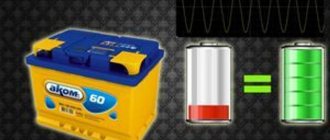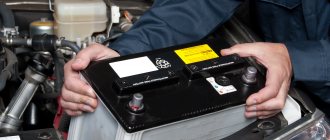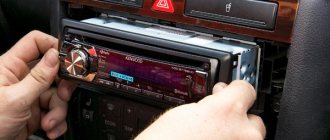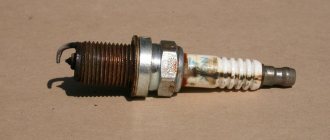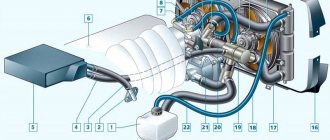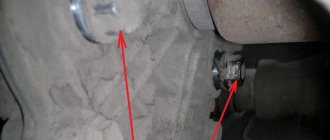How to charge correctly
Fast battery charging is only permissible in the most extreme cases
The need to recharge the battery may arise for various reasons.
Most car owners do not realize that there are certain rules and regulations that must be followed in order not to damage the battery.
Before you begin the recharging process, you must remove it from the engine compartment.
Rules for recharging the battery:
- Charging should be carried out for at least 12 hours. Charging for less time will only damage the device and may cause its service life to be significantly reduced.
- The charging process must be carried out exclusively with factory-made devices. Homemade devices that various craftsmen create in garages can harm the battery and simply ruin it.
- It is best to charge the battery by placing it on a hard, flat surface to avoid various unpleasant incidents.
Using simple tips, you can charge your device safely.
Specifications
The car battery has a plastic case in which lead plates are compactly arranged. Each element is sealed in plastic screens.
The plates have different lead compositions. The plus of the battery consists of lead dioxide, and the minus of finely porous lead. The sulfuric acid electrolyte actively interacts with the substances of the plates. A chemical reaction occurs and an electrical current is generated. If the battery lands, the plates are destroyed.
What affects battery life?
To begin with, let's briefly look at the service life of a car battery made according to the classical design, based on lead plates using an electrolyte (although many of them are also typical for batteries made using new, more advanced technologies). So, the following factors influence the service life of the battery:
- Workmanship. Everything is simple here - well-known global manufacturers produce their batteries under brands with a warranty period of two to four years. In fact, such batteries last five to seven years or even more. Cheap Chinese or domestic batteries provide a guarantee of 6...12 months, and such batteries last for at most three years.
- Operating temperature conditions. It is known that in winter, at low operating temperatures, the battery capacity drops and it operates in more difficult conditions than in summer. However, this is compensated by the fact that the engine warms up before the trip in winter, and the capacity is more or less restored. However, short trips in winter are detrimental to the battery. It is recommended to carry out the desulfation process at least once every two to three years (it can be done with your own hands).
- Battery performance. In particular, whether the battery is serviceable or maintenance-free. Typically, maintenance-free ones last longer, provided they are recharged on time. However, if distillate is added to a serviced battery in a timely manner and also recharged, then its service life may be even longer than that of a non-serviced one.
- Charging system is working properly. In particular, this applies to the generator and its voltage regulator. So, if the voltage in the circuit is too high, this can lead to overcharging. For example, for gel batteries this is very critical. If the regulator produces too low a voltage, the battery is undercharged, which can lead to “deep discharge”. And a couple of such situations completely damage the battery.
- Leakage current value. If third-party equipment, which takes electricity from the battery when the engine is turned off, is connected incorrectly (or the wrong power is selected, or its power is too high), then it can significantly discharge the battery. This is fraught with the fact that literally in a week a “deep discharge” can occur with the consequences described above. Therefore, if the battery is constantly discharged on a regular basis, it is recommended to measure the battery leakage current. This will increase the average life of the car battery.
- Driving in the city cycle. According to statistics, the batteries of cars that are mainly used for driving in the city have a shorter service life. This is explained quite simply. In this mode, trips take little time. That is, the battery supplies energy to start the engine, and the trip takes a short time, during which it does not have time to replenish the expended energy. This results in a slight undercharge. If this is repeated constantly, then it is significantly discharged, which leads to a decrease in its service life. However, this does not apply to situations where the car sits in traffic jams for a long time with the engine running. In this case, there is enough time to replenish the expended energy. If there are no traffic jams in the city, then you need to drive a car for a long time approximately once every one or two weeks - about 30...40 minutes.
- Battery mount. It must be firmly fixed in its seat so that during sharp turns or driving on uneven roads, normal electrical contact is ensured and the battery terminals are not broken. Even minor vibrations and displacements over time can damage the battery or simply reduce its service life.
Thus, the answer to the question of how long a car battery lasts depends on the listed factors. Most batteries have information about their date of manufacture. Usually it is specially encrypted and placed on a label with other battery markings glued to their case.
How to store a flooded battery?
In this case, the batteries already contain electrolyte (mostly liquid) and it is charged at the factory. The storage space for such batteries is subject to the same requirements as for the previous type. But since the battery already contains electrolyte, the temperature regime will be slightly different.
And since it is sensitive to this parameter, its service life will be different:
- From 0 °C to 20 °C – no more than 18 months.
- At temperatures above 20 °C – 9 months, no more.
It is worth noting that this type of battery is characterized by the presence of a small self-discharge, which fully depends on the temperature regime.
During storage, it is recommended to periodically charge the car battery. However, not every seller, even if necessary, decides to open the original packaging. But this is a violation of the battery’s shelf life before use.
Therefore, buyers should be interested in how long the battery has been stored. This will then allow you to decide whether to charge the new battery before subsequent commissioning or not.
Impact on the service life of battery technology and manufacturing quality.
Progressive technologies, modern materials and quality control in production can really significantly increase the service life of batteries.
Brands known for product quality offer products for which a service life of 5-7 years is quite realistic. Most often, these are maintenance-free batteries with a warranty period of 2-4 years.
There are a large number of batteries on the market that last up to 3 years. The quality of their production is inferior to the best samples, and their manufacturers provide a guarantee of no more than 6-2 months.
They differ not only in technology and materials. The corresponding difference can be seen in prices. But the desire to save often results in greater costs in the future.
In addition to quality and technology, many other factors influence battery life:
- Design and execution;
- Temperature;
- Condition of the vehicle's electrical equipment;
- Driving mode;
- Fixing the battery in the seat, etc.
Execution and design.
Purchasing a serviceable battery gives the motorist the opportunity to more accurately control the condition and freedom of action during maintenance. This requires strict adherence to the rules and regulations - a missed moment by the owner to add electrolyte or correct its density can result in complete failure of the battery.
In this regard, a maintenance-free battery is simpler and more reliable, which is also reflected in the service life.
Temperature.
Deviations in temperature conditions, both towards low and towards high temperatures, negatively affect the condition of the battery.
At low temperatures, the battery capacity decreases, and current loads increase when starting a cold (with thickened lubricant) engine. This leads to rapid discharge and incomplete charge from the generator and an increase in the intensity of sulfation. In addition to the loss of ion mobility, there is a risk (in severe frosts) of partial or complete freezing of the electrolyte and warping or damage to the plates.
In the summer, at high temperatures under the hood, the processes of sulfate crystallization proceed faster. In addition, as the temperature increases, corrosion develops more intensely. At the same time, it becomes more difficult to notice negative aspects - even if the charge drops by 50%, the battery can cope with starting the power unit quite well.
Condition of electrical equipment.
The following are especially important for battery operation:
- Generator status. When operating in nominal mode, a normal battery charge level is maintained; periodic (depending on the season) recharging from an external charger is required. If there are problems with the generator, deep discharge, accelerated sulfation and reduced battery life are possible.
- Operation of the regulator relay. Good condition guarantees no overcharging, which allows you to count on long battery life.
A charge at elevated voltage is no less dangerous than a deep discharge. During the process, active electrolysis of water occurs with the release of hydrogen and oxygen. As a result, the electrolyte level decreases (incompletely coated plates become more corroded and fail) and its density increases.
The position of the remaining equipment and wiring is no less important. The appearance of leakage currents, the connection of consumers operating at times when charging is not occurring (for example, alarms and radio tape recorders) increases the likelihood of deep discharge and shortening the life of the battery
Driving mode.
Operating a vehicle in urban cycles reduces the life of the battery. Starting the engine for a short trip is the most difficult mode. Due to high starting currents, the battery is discharged, and during the trip the generator does not have time to restore the charge. In the future, such undercharges lead to deep discharge and accelerated sulfation.
Battery mount.
Reliable fixation of the battery on the seat will protect against shifts during maneuvers and reduce vibration mechanical loads. This eliminates the possibility of an external short circuit and significantly reduces the likelihood of an internal one.
Factors that reduce battery life
The battery delivers its maximum starting current at . When driving short distances, the battery will quickly fail because it does not have time to charge. Connected devices and air conditioning actively destroy the battery. The battery is able to qualitatively restore its balance only when driving over long distances.
The service life of car batteries depends on the conditions under which the vehicles are used.
The Avto-Blogger channel presents the correct charging of the battery according to time.
Finding the battery in a discharged state
A discharged battery condition is catastrophic. The process of sulfation occurs and the density of the electrolyte decreases. The solution to the problem is to replace the electrolyte and charge with a small current.
Short circuit
A short circuit of the battery leads to its immediate failure. As a rule, when a short circuit occurs, one of the cans is damaged. The lead plates completely disintegrate. A short circuit can be caused by elements that have fallen off the battery due to age.
Corrosion
Corrosion of battery plates occurs due to long use. This process signals the owner to replace the battery soon.
Deep battery discharge
When the battery is deeply discharged, the plates become sulfitized and disintegrate, which can affect the reduction.
Battery discharge occurs for the following reasons:
- Large current leakage caused by faulty electrical equipment. The leakage should not exceed 100 milliamps. If the value is higher, then the car’s battery will quickly discharge when parked. The possibility of a car fire cannot be ruled out.
- Incorrect operation of the generator. The on-board voltage should be no more than 14.4 V. If the recharging generator produces a higher value, then overcharging will occur and the battery will quickly become unusable.
- Riding mode. In cars that are driven over short distances (up to 5 km), the battery is constantly in an uncharged state. This contributes to the rapid failure of the battery; such devices last no more than two years.
Excessive battery charge
Overcharging the battery causes the electrolyte to boil away and disintegrate into hydrogen and oxygen. The electrolysis process is very dangerous because hydrogen ignites at the slightest spark. The battery is overcharged from both the charger and the vehicle's alternator. From this we can conclude that the battery must undergo periodic maintenance.
Other
Operating a car at both high and low temperatures leads to rapid battery failure.
In hot weather, the temperature in the engine compartment reaches up to 90 degrees and water boils away. A decrease in electrolyte level leads to a decrease in capacity. The manufacturer gives the warranty period for the battery based on normal temperature conditions.
Real lifespan
If you keep the battery charged and the car's electrical systems in good working order, then the service life of the car battery can easily be increased by a year, or even by 2-3. With normal care, the battery can last 5-6 years. There are cases of proper operation of the battery for up to 7-8 years.
We invite you to read: Deadlines for filing an application for inheritance after death
Unlike the shelf life of a new battery before use, its service life is affected not only by the vehicle's mileage (or engine hours). There are a number of other factors to consider:
- The resource of the entire structure, which includes several components - the amount of active mass, the alloy of the plates, the quality of the electrolyte, compliance with production technology. It is very important that the battery arrives to customers in a “fresh” form.
- On-board vehicle system. In particular, we are talking about its energy saturation. If the generator's capacity is exceeded, including current leakage, this leads to undercharging of the battery. As a result, the battery life is reduced.
- Incorrect operation of the generator can result in a deep discharge of the battery. In turn, this brings the deadline for its write-off closer.
- Due to violations of vehicle operation rules in winter, battery banks may freeze if the electrolyte loses its density. This, in fact, may be the end of the battery life.
- If you keep the car battery clean during the entire storage period before using it, charge it in a timely manner, and also check the electrolyte from time to time, then you can preserve the long service life of the battery.
When the battery is running at about 60% charge or in case of overcharging, sulfation may occur due to a faulty voltage regulator.
This is also fraught with detachment of the active mass from the battery plates and lead oxidation. Ultimately, the resource, including battery life, is noticeably reduced.
What factors affect battery life?
The service life of a car battery depends on a number of factors:
- device type;
- material that was used in production;
- technical characteristics of the device;
- operating mode (or storing the battery without use);
- total number of charging cycles;
- terms of Use.
When using a car battery, you should pay attention to the following points:
- Battery type (maintained or maintenance-free). Car owners who use the type of device being serviced need to take care of it in a timely manner: add distilled water, check the density of the electrolyte, etc. If you miss the right moment, the device may not last even one year.
- Technical breakdowns in the battery charging system. If the car has problems with the generator, this will automatically lead to the battery being discharged, which will very quickly disable it in the future. In addition, a malfunction of the regulator relay can cause the battery to overcharge, which should not be allowed.
- Leakage current. The car is equipped with various devices that operate on current (alarm system, radio, etc.). If errors were made during their installation, electric current may leak, which will lead to a gradual discharge of the battery. If such a problem is discovered, it must be resolved urgently.
- Duration of trips. Batteries installed in city cars last less. This is due to the fact that with frequent trips over a short distance, the battery does not have time to charge and the voltage may drop to a critical level.
- Mounting the battery in a car. If the battery is installed incorrectly, it may move out of place during sudden maneuvers while driving. This can lead to the fastening point itself breaking or the terminal being shorted to the body. For proper operation, the battery must be firmly secured in place.
How to extend battery life
The following tips will help extend the battery life:
- Do not use a discharged battery;
- in the winter season, the battery needs to be recharged by letting it work for 10-15 minutes without the load of electrical appliances;
- With a manual transmission, pressing the clutch will make it easier for the battery to start the engine;
- it is necessary to remember that the starter consumes a lot of energy from the battery, so you do not need to crank it for more than 5 seconds at a time;
- it is necessary to regularly inspect the battery, clean the terminals and the battery case itself from any deposits that have formed;
- Charge the battery regularly to maintain voltage;
- If the car is not going to be used for a long time, it is better to disconnect the battery terminals or remove it altogether.
If you adhere to the above rules when operating your car, the battery will last much longer.
Signs of a bad car battery
Sooner or later, depending on the above factors and operating conditions, the battery will fail. The following signs will indicate a battery malfunction:
- rapid loss of charge by the device;
- the battery does not hold voltage when charged;
- The battery does not start the car engine, although it was recently charged;
- oxidized battery terminals;
- problems with the functioning of electrical equipment in the car;
- presence of damage to the battery case;
- sulfation of battery plates;
- excessive heating of the battery during charging;
- unpleasant odor from the device.
You can more accurately determine a battery malfunction using additional tools: a load fork, a tester, a voltmeter. If you have some skills, you can use them to understand how critical the condition of the device is.
By regularly inspecting the battery and following the operating rules, you can maximize its service life and avoid sudden problems with starting the car.
Proper use – long battery life
To increase the service life of a car battery by several years, you will need to create ideal operating conditions for it, which is almost impossible in practice. Thus, there is a negative effect on the battery of low and high temperatures, but it is impossible to completely eliminate them. If frosts lead to a decrease in battery capacity and possible deformation of its case, then high temperatures can lead to overcharging (due to active evaporation of water and an increase in the density of the electrolyte). Both of these significantly reduce battery life.
Quite often, inexperienced drivers make a rather serious mistake by adding electrolyte to the jars, which cannot be done, since the decrease in the level occurs due to the evaporation of water, while the amount of acid does not change. If the electrolyte level in the battery being serviced has decreased, add water, and that’s it. A common cause of premature battery wear is its constant undercharging. If, in addition, this is accompanied by high operating temperatures, sulfation phenomena are often observed, the process of which, unfortunately, is irreversible.
It is necessary to think about the service life of a car battery even at the stage of purchasing it in a store. Currently, you can buy a battery filled with electrolyte at the factory, or you can prefer a dry-charged version designed for self-filling. There is no significant difference in the service life of both options, however, in the case of a charged battery, it is more likely that the electrolyte in it meets the standards for density, quantity and purity. Many drivers think about how to extend the life of a car battery, but do not take into account such an important point for this as the complete serviceability of all electrical equipment installed in the car.
A modern car has a huge amount of standard electronics, which is almost always supplemented by independently installed equipment. Additional equipment is not always connected correctly, and in some cases leads to increased electricity consumption. Then, when the consumption does not have time to be replenished, and the vehicle owner does not burden himself with periodic checks of the voltage at the battery terminals, the rate of its wear rapidly increases. The frequency of the check is, in principle, not regulated, and it can be performed as often as desired.
Important! The normal voltage of a working battery is 13.8-14.5 V.
Inverters are becoming increasingly common in cars, allowing the use of electrical appliances connected to a 220 V network. Uncontrolled use of such converters is also a common cause of premature battery wear and reduced service life. It is necessary to understand that the operating time of the inverter from a car battery is quite limited, and in most cases, when you turn on the engine, it must be turned off, otherwise it may burn out (unless the protection suddenly works). Therefore, you need to use the inverter extremely carefully and, preferably, for a short time. You can watch the video on how to choose a new battery and some of the nuances of its operation:
Proper handling of the battery is the key to increasing its service life for the benefit of its owner.
- The battery charging light in the car is on
- Features of the correct choice of battery
- Tips for lighting a car battery and procedure
- Low battery and technical assistance service
How long should a battery last?
Frequent use of an undercharged battery will degrade its performance. As you can see, the operational properties of such equipment are influenced by a whole set of processes and factors. The battery that fails most quickly is in cars that are used as taxis, where the service period may not exceed 1–1.5 years. But there are also situations when a driver manages to drive on one battery for 6 or more years.
Despite the fact that there is a concept of a warranty period that the manufacturer must comply with. The Ministry of Transport has established a certain standard. It is regulated by document RD-3112199–1089-02. This guidance document deals with the service life of lead acid batteries in various vehicles.
This is in demand when calculating depreciation and writing off car batteries based on their service life.
To extend the life of your battery, you need to take proper care of it. It would be a good idea to check the voltage level at the battery terminals using a load plug 1-2 times a month. It is also necessary to check the electrolyte level and, if necessary, bring it to normal, as well as the density using a simple device called a hydrometer.
Sincerely, blog author Andrey Kulpanov
The operating life of the batteries may depend on the factors indicated in the table.
| Purpose of cars | Average service life, years | Mileage, km |
| Commercial | 4 | 100000 |
| Taxi | 2 | 140000 |
| Individual use | 5-6 | 70000 |
| Service transport | 3-3,5 | 120000 |
What affects service life?
The battery life is affected by many processes and various irritants. Let's look at these factors.
- Charge level. The first step is to find out the battery power. Sometimes it happens that the battery consumes much more energy than indicated in its technical data sheet or, on the contrary, is discharged very often. You need to know that frequent discharges of the car's power source can lead to its incorrect operation in the future. As a rule, it takes a day to fully charge the battery, but this is not always the case. Before you remove it from charging, you need to make sure that it is fully charged. The more electronic equipment installed in a car (air conditioning, on-board computer, alarm system), the greater the power consumption. To maintain balance, it is necessary to use both the car and the car battery correctly. For example: using the air conditioner during a short trip consumes a lot of energy, so the energy does not have time to be generated. Its excellent balance at pancake distances;
- Temperature. The electrolyte (the main element of the battery) is very severely affected by weather conditions, especially frost. So, the impact on the battery of frost causes the viscosity of the electrolytes, and this, in turn, prevents the normal flow of charge. Elevated temperatures also negatively affect the power source: the liquid boils away, which leads to the possibility of overcharging. It is believed that it is the influence of low and high temperatures that is the main reason for the short service life of the battery, as this leads to a decrease in battery capacity, defrosting of the electrodes, deformation of the case, shedding of the electrodes and a tendency to corrosion;
- Short circuit. A short circuit completely disables the power source. Short circuits in new cars may be caused by defective parts. As for old cars, the situation is different. Paste falls off the batteries, which creates what is called active paste sludge. When there is a large amount of this sludge in the car's power source, a short circuit of oppositely charged particles occurs;
- Sulfation. To put it simply, this is the oxidation of the plates. This process occurs when the electrodes do not receive voltage, even if it is passed for a very long time. The reason for this is a sharp increase in temperature, which leads to an increase in the density of the electrolyte.
Service life depends on operating conditions
The second important aspect is the operating conditions of the battery. Undercharging or overcharging a battery can significantly reduce its capacity, and therefore its service life.
So, if we give the dependence on discharge cycles, while taking into account the “depth” of discharge as a percentage, then the number of cycles will be directly proportional to these conditions. The stronger the discharge, the fewer full cycles the battery can survive. This dependence is clearly visible in the form of a graph
As for overcharging, this is also a very harmful phenomenon for the battery. With continuous charging, its capacity changes upward, accelerated oxidation of the electrodes, and possible coloring. With subsequent charges, during such processes, the capacity, on the contrary, will drop below the nominal value, due to the loss of electrolyte when it overheats. As a result, after several recharges it is quite possible to damage the battery.
The voltage regulator must monitor the recharging of the battery. Today, such a regulator is in most cases installed directly in the generator. That is, it is necessary to monitor the serviceability of the generator. Of course, you should not forget about the operating temperature. At low operating temperatures, the battery capacity drops significantly. The battery also operates in modes other than nominal. It discharges faster and charges faster, which naturally increases the number of charge-discharge cycles and reduces the battery life in terms of operating time. It must be said that modern high-quality batteries can successfully operate for 8-10 years without causing their owners any trouble. The whole point here is how close the operating conditions will be to the desired ones described above.
What factors affect the shelf life of a car battery?
The girl faced the problem of battery discharge right on the road.
Do you want to know what the average service life of a car battery is and how long it can last? This is influenced by many external factors that every car enthusiast should be aware of. On average, the service life of the battery should be at least 3.5 years. A battery of any make and year should last this time in any car, of course, if it is not completely discharged and does not waste a lot of energy. Or rather, more energy than she should spend.
The main devices that consume a large amount of energy are:
- multimedia system, as well as all kinds of electronic devices;
- mechanisms for opening doors, driver safety;
- climate control system;
- on-board computer.
All of these elements affect the life of the battery because they draw power from the battery, even while the vehicle is parked. Moreover, if there are non-working devices and instruments in the electrical equipment, the battery will constantly be in a discharged state
As a rule, our drivers rarely pay attention to this; usually the commotion begins when the battery fails to start the engine. Therefore, if you do not plan to use the car for a while, it would be better to disconnect the terminal from the battery
Variety of batteries
It should also be taken into account that the service life of a car battery largely depends on weather conditions. When it's cold outside, the efficiency of the device drops significantly because the electrolytes in it become viscous, resulting in increased resistance to charge movement.
As a result, regardless of the year of manufacture and correct operation, the life and shelf life is reduced due to:
- deformation of the battery case;
- decrease in capacity indicator;
- electrolyte freezing;
- periodic defrosting of electrodes.
If the vehicle is regularly used in high temperatures, this will also affect the service life and suitability of the battery, regardless of the year of manufacture.
Moreover, the service life of a car battery is not only reduced, but the device may even fail as a result of:
- recharging the device;
- possible self-discharge;
- corrosion formation;
- too high moisture evaporation (video author - HotSEM).
Of course, one of the main components of any vehicle's electrical system is the alternator, so it also affects battery life. Regardless of what the date is and what year of manufacture and how old the battery is. If the charge is very low, then sulfation of the plates occurs in the battery device, and the regulator relay also contributes to the decrease in shelf life, due to the breakdown of which an increased voltage appears in the on-board network. If the cans overheat due to high voltage, this may cause the electrolyte to boil away.
Don't forget about vibrations. The shelf life, regardless of the date and year of manufacture and how old the battery is, decreases with constant vibrations in the system. Due to vibrations, the coating of the plates is destroyed, sometimes cracks can appear on the battery, and this, in turn, completely kills the device.
If vibrations occur when the vehicle is moving, it is necessary to get rid of them as quickly as possible, because they contribute to:
- voltage surges in the on-board network;
- the appearance of a short circuit;
- battery sulfation.
An important point is the way you drive the car. As a rule, if a vehicle is used only in the city, then the service life will be lower than that of a car that spends more time traveling on the highway. This is because in city mode, when operating the car, the engine starts much more often, and trips are usually not long, so the battery simply does not have time to restore its capacity. Particularly undercharging of the device often manifests itself in the winter season, because in addition to frequent engine starts, constantly used lighting devices do not allow restoring the device’s capacity.
Charging the battery using a charger
Age verification
Timely replacement of the old battery is only possible if the owner carefully monitors and records all dates for replacing components. It is simply impossible to keep all the information in your head, especially considering that a high-quality battery can last 5 years or more. In addition, sometimes car enthusiasts buy used cars. You should not trust the seller unconditionally. The battery life can be easily checked.
We recommend: Features of Korean car batteries
There are no universal rules for date placement. Different manufacturing companies have different labeling methods. Well-known Western brands (Bosch, Berga, Balckmax, Varta, etc.) have a code of 24 characters. The fourth position from the left indicates the year of production, and the fifth and sixth positions indicate the month.
The Titan Arctic and Titan companies have the month and year positions swapped. You can find information about the year of manufacture on the fifth and sixth digits, and the month of manufacture under the third and fourth serial numbers. A special system was introduced by battery manufacturers Bost and Atlas. When searching for the year of manufacture, you should pay attention to the first digit. Behind it you can find letters that indicate the month of production.
Information about age verification methods can be obtained from your retailer or online. Operating instructions for each model are most often freely available. With such information, you can closely monitor the service life and carry out timely maintenance and replacement.
Battery maintenance rules
The performance of the car directly depends on the condition of the battery. To do this, you must strictly follow all stages of battery maintenance.
Visual inspection
Inspections are carried out at least 2 times a month. If during diagnostics salt is found on the body or electrolyte leaks, they are removed using alkaline solutions. It is also acceptable to use baking soda for cleaning. It neutralizes acid and removes dirt and dust from the body. Multiple electrolyte leaks can be caused by microdamage to the battery case. If not regularly cleaned and repaired, this will cause the battery to self-discharge and fail.
Charge level measurement
This is done using a multimeter or voltmeter. To do this, disconnect the terminals of the vehicle’s on-board system from the battery terminals, and connect the device sensors in their place. An acceptable voltage level is considered to be 12.6-12.9 V. If the device readings are below the standard, the battery needs to be charged from the network. To check the voltage in the on-board network, connect the terminals, start the engine, and turn on several electrical appliances. The voltage reading should be 13-14.4 V.
Important! European voltage measuring instruments differ from Russian ones in the arrangement of terminals
Checking the electrolyte level and density
Many modern models have panels on the body that display information about the density and electrolyte level. If such a function is missing, you can take measurements yourself. This does not require removing the battery. Remove the lids from the holes located on the jars and immerse a transparent glass or plastic tube into them. When it touches the plates, it is removed and the height of the remaining mark is assessed. Ideally, it should be at least 10 mm.
Reference! Measurements are taken with a fully charged battery and a temperature of at least 25 degrees.
To measure the density of the electrolyte, a hydrometer or densimeter is used. The tip of the device is immersed in the liquid, making sure that it does not touch the walls of the battery, and then the readings are taken. The norm is considered to be results of 1.27-1.29 g/cc. If the result is unsatisfactory, it is corrected by pouring distilled water or electrolyte into the battery.
Leakage current measurement
This is done in the same way as charging a battery. The difference in the operations is that the multimeter is set to current measurement mode. Current leakage will cause the battery to quickly discharge and will not allow it to fully restore its charge. If a problem is detected, it is necessary to find out the causes of the leak and eliminate them.
Charging the battery
Under regular use, the battery is charged from the generator. When using a wall charger, we are talking about recharging. This procedure should be carried out at least once every 3 months. Unscheduled charging occurs when the battery is completely discharged. This situation can be provoked by: leaving the car in a garage for a long time without moving, turning on the high beams and the music player. Charging is carried out in uninterruptible voltage mode.
Reference! In winter, when the battery is constantly exposed to low temperatures, more frequent charging will be required.
Checking the condition of the battery with a load fork
This device puts a load on the battery that simulates the load that occurs when starting the engine. In normal operating condition, the voltage should not drop for more than 5 seconds.
